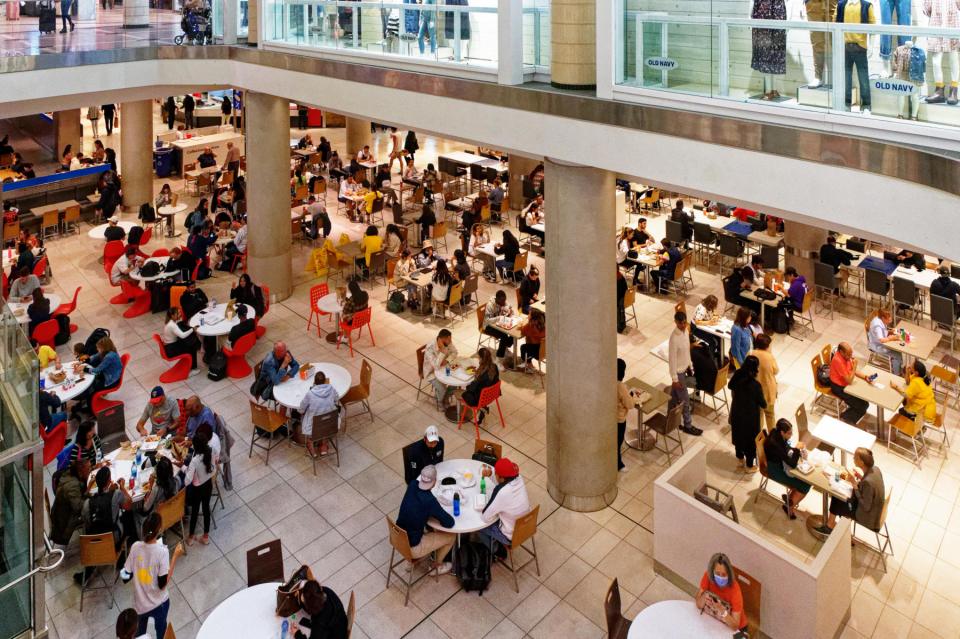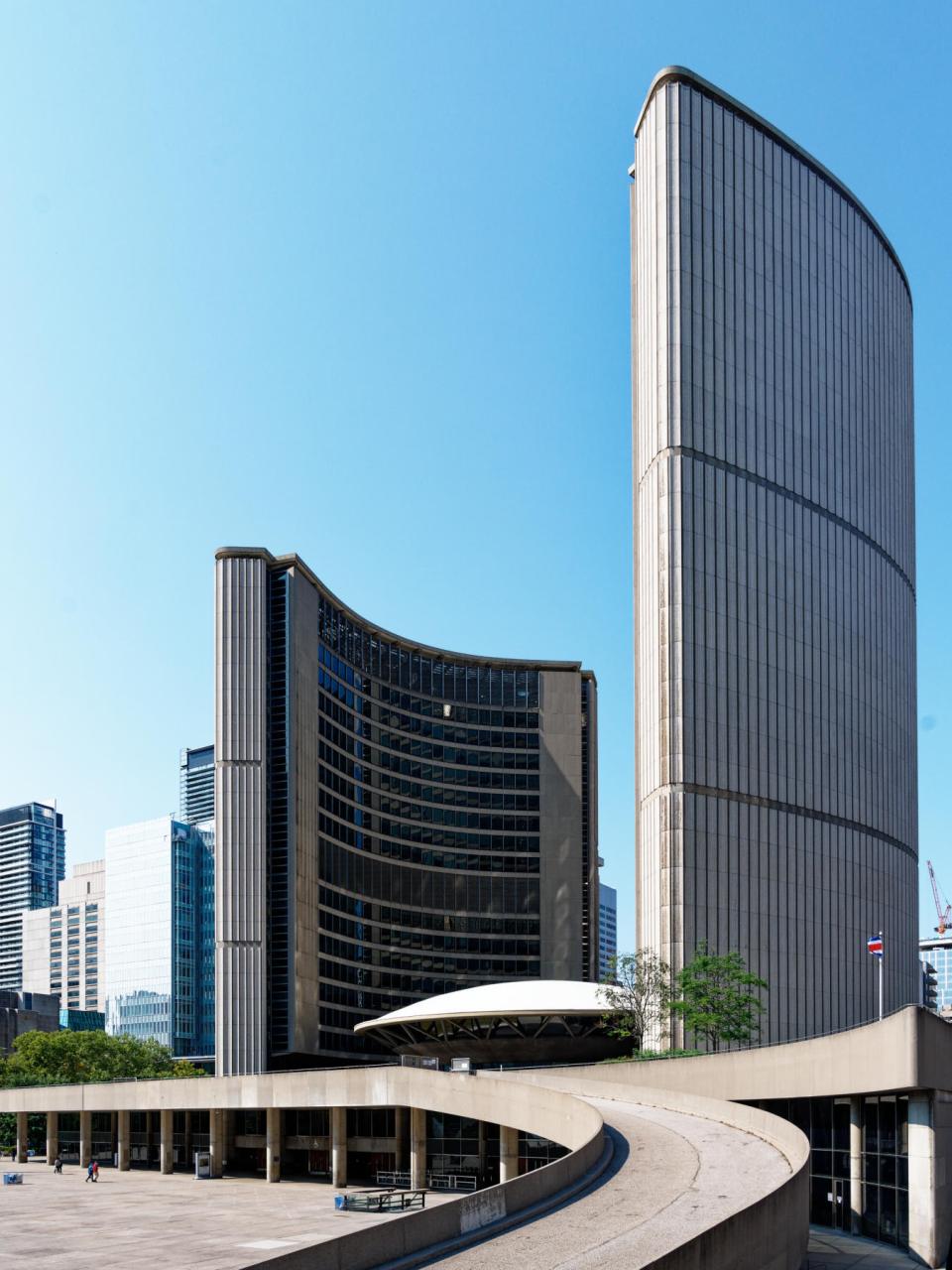Tuesday 20 September 2022 – The weather forecast for the day was gloomy, and the reality out of our hotel window

didn’t give huge cause for elation. So, by an accident of fate, our plan to be on a bus for most of the day looked pretty sound. There was a little uncertainty about precisely where the bus would stop, as a result of which we failed to be first on it and therefore to get the prime seats at the front of the upper deck. This was a little bit of a shame, as the front windows actually boasted windscreen wipers, and so would have been clear for taking photos.
The driver, Dan, gave an interesting and folksy commentary as we went along and we tried to grab photos of the things he was talking about – never easy on a reasonably swift-moving bus on a rainy day, but one or two are worth sharing.
The route went north-east from Québec City, along the north coast of the St. Lawrence river. This is the area where original settlers, erm, settled, and it seems that it took a few years for them to find the best area: at first they made homes on the banks of the St. Lawrence, but these got washed away by the unexpectedly high tides; so the next attempt was on top of the cliffs that bordered the river, but these were subject to the bitterly cold north-easterly winds; finally, the best location turned out to be at the foot of the cliffs, out of the reach of the tides and sheltered from the winds.


By this stage, the settlers had learned about the potentially 12 feet of snow that could be expected during the winter, and so the houses tended to have steps up to the entrances. We tried to catch some pictures of these houses as we went by.


On thing that we noticed was the colour of the roofs, many of which were (like that church spire I mentioned in my last post) silver in colour. It turns out that these are tin, chosen because it is reasonably long-lasting and also fire-resistant. Many have brightly-coloured roofs.


The reason for this is historical, as there’s no real need for the colour now. But in the days of the original settlers, with houses relatively few and far between and 12 feet of snow on the ground in winter, the coloured roof was perhaps the only landmark a person could see. The house in the photo immediately above features a “spring kitchen” – a place where folk could gather as the weather broke after winter, to celebrate the arrival of spring.
Houses that were farms tended to a strip of land that stretched back to the banks of the river – that way it was easy to understand land ownership. Some of the farm houses are very handsome


and some of the older buildings show , from the reduced height of the door, that people weren’t as tall then (late 16h and 17th century) as they are today – perhaps as much as a foot shorter on average.
The tour made its first stop in St-Anne-de–Beaupré, a small town of perhaps 3,000 souls, but home to an astonishing Basilica. The first church was built by sailors, seeking protection against shipwrecks off Ile-Oeuf on their way upriver to Quebec City (Saint Anne, the mother of the Virgin Mary, is the patron saint of sailors). But the church has grown and grown, and has a reputation similar to that of Lourdes as a place for the sick to come on a pilgrimage and be cured.
It is huge

and ornate, both outside

and inside.






The doors are covered in beautiful copper, both outside

and in.

and there are extraordinary stacks of crutches and other mobility aids

which have been left here by people who have been cured of their illnesses.
There are no fewer than three other religious establishments immediately around the Basilica,



a couple of churches and, above, a commemorative chapel of the third church. On the gentle slopes of the hillside behind the chapel and beside the Santa Scala pictured above it are twelve bronze statues of the Stations of the Cross.


All in all, it is clear that Sainte-Anne-de-Beaupré is a very significant religious centre. There’s something excitingly called a Cyclorama

which is not, after all, a wall of death for daredevil motorbikers to whizz round, but actually a 365-ft representation in the round of Christ’s crucifixion – sadly closed since the pandemic and not yet re-opened.
After this stop, we retraced our journey back towards Quebec City. Driver Dan described the next stop as a “Copper Shop” and I wondered why we would visit a police station. At first, it seemed merely the sort of retail opportunity that is often an unwelcome intrusion into a tour, as we were ushered into the lobby lined with works of art made from copper. I was wrong to misjudge it, though. We were at Cuivres d’Art Albert Gilles Boutique et Musée. Our group was given a short demonstration of how sheet copper can be transformed into a work of art.




although what we saw was a mere illustration using thin sheet metal; the real material is five times as thick and takes real skill, dedication and time to make into a final sculpture.

The studio, which was started by Albert Gilles who has passed the flame to daughter and grand-daughter, also hosted an exhibition, including Albert’s work to create silver representations of the life of Christ,

a project which took him 15 years, as well as some other lovely items.

The key thing that prevented this from being an unwelcome attempt to sell us stuff came with the knowledge, imparted by Madame, that Albert Gilles had created the copper doors for the Basilica at Sainte-Anne-de-Beaupré (along with work at some 60 other churches). We left with a great, erm, impression of the man, his work and his art.
We next stopped at the Montmorency Falls. These are 83 metres high, thus higher than Niagara, although not as powerful.
The falls are impressive enough from ground level, but one can reach the top for a different viewpoint. You have a choice: walk up steps to the right of the falls as you look at them – 487 steps, we’re told, since we didn’t take this option (not enough time) – or a cable car to the left, which is quicker, less work but costs more.

The cable car is unique in my experience in two ways: the cars are clamped to the cable and it’s the cable that moves; and each car is clamped to two cables, which (obviously) both move. From the top of the cable car, you go past Montmorency Pavilion

and can take a couple of viewpoints, the better of which is ruined, in my photography-solipsistic world, by zipwire cables spoiling the view. There’s a suspension bridge across the falls, which is quite exciting. On the left from this viewpoint you can see the steps which hardy souls can climb and which would probably give the most satisfying viewpoint.


In the distance, in the upper of these two pictures, you can see a much larger suspension bridge. This leads to – indeed is the only road access to – the Île-d’Orléans, which is where we headed next.
This island is home mainly to farms, as building regulations forbid the creation of any other kind of industrial construction. It produces mainly fruit and vegetables – strawberries, apricots, potatoes and apples. There’s a 9-hole golf course, a couple of churches and a decent selection of very handsome (and expensive, obvs) homes. There’s a Nougaterie, and a blackcurrant farm, Cassis Monna & Filles, which Ian Burley recommends for its gin, but rather than go there, we ended up at a chocolate shop, right at the western point of the island, where you can actually see back over to Québec.

If you look carefully, you can even see the central tower of our hotel, just above the left-hand cruise ship.
The chocolate shop is very obviously a popular place for tours

but we resisted the urge to dash in and stuff our faces. Instead, since this was the last stop of the tour and we were back at the hotel shortly afterwards, we headed to a hotel restaurant called Sam (for reasons we discovered the next day) where, by virtue of force of personality, or perhaps just plain luck, we just managed to squeeze in for a late, and very good, lunch and a couple of cold, and very welcome, drinks.
Was this a “Fabulous Country Tour”? Well, not really – and of course the dull weather didn’t help – but it was interesting and we learned quite a lot about early settlers; and the Basilica was a truly remarkable place. We enjoyed the day and could now look forward to our second and final day in Québec. The weather outlook was rather better, so we could expect to have a good chance to explore this fascinating city in more detail. Do come back and find out, won’t you?

























 (above imaginatively called “Bear Catching Fish)
(above imaginatively called “Bear Catching Fish)
 (The above is called “Our Shepherds”. The accompanying description says “The playful blue colour and simple, symmetrical structure of the sculpture acts as an enticement to consider deeper meanings. Our Shepherds speaks of those who take power and those who are led, inviting viewers to question who are the shepherds and who are the sheep.” This is a load of pretentious bollocks in my view.)
(The above is called “Our Shepherds”. The accompanying description says “The playful blue colour and simple, symmetrical structure of the sculpture acts as an enticement to consider deeper meanings. Our Shepherds speaks of those who take power and those who are led, inviting viewers to question who are the shepherds and who are the sheep.” This is a load of pretentious bollocks in my view.) (A representation of The Stanley Cup, the Canadian ice-hockey trophy)
(A representation of The Stanley Cup, the Canadian ice-hockey trophy)
 (Maman, outside the Arts Museum and across the road from Notre Dame)
(Maman, outside the Arts Museum and across the road from Notre Dame) (a cute advert for a bicycle rental establishment)
(a cute advert for a bicycle rental establishment) (York Street Steps)
(York Street Steps)




































 (this last, showing a host of ATMs in a pretty much deserted hallway, reminds me that this was quiet because the sun was shining; during the winter, I bet it’s much busier.)
(this last, showing a host of ATMs in a pretty much deserted hallway, reminds me that this was quiet because the sun was shining; during the winter, I bet it’s much busier.)




























